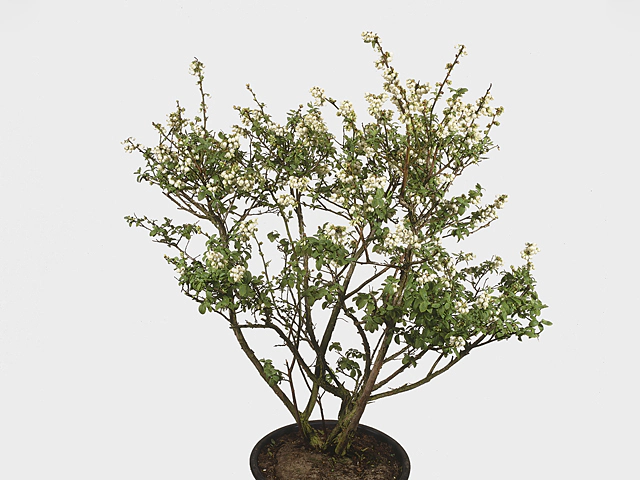Vaccinium corymbosum

| Fruit type | Berry |
| Leaf type | Foliage leaf |
| Winter hardness | Good (USDA-zone 5, 6) |
| Flower color | Yellow; White-white-155D |
| Leaf, general shape | Ovate (egg-shaped); Elliptic / oval |
| Flower diameter | Small; 1 - 10 mm |
| Plant height | 1,2 - 1,4 m; 1,8 - 2 m |
| Inflorescence | Raceme |
| Flowering month(s) | May |
| Leaf duration | Deciduous |
| Flowering period | Spring flowering |
| Leaf size | 5 - 7,5 cm; 3 - 4 cm |
| soil pH requirement | Acid (pH < 4,5); Slightly acidic (pH 4,5 - 6,5) |
| Light conditions | Sunny; Semi-shades |
| Leaf division | Simple |
| Leaf, main color | Dark green |
| Leaf colour, pattern | Unicolored |
| Flower, secondary color(s) | Dark pink red |
| Moisture requirements | Well-drained; Moist |
Bilberry, also known as highbush blueberry or blue berry, belongs to the Vaccinium corymbosum species. This fruit is a type of berry and is highly sought after for its numerous health benefits. Not only does it taste delicious, but it also offers a range of nutrients and antioxidants.
The bilberry plant is known for its good winter hardiness, making it suitable for USDA zones 5 and 6. It can withstand cold temperatures, ensuring that it thrives in colder climates. The plant has foliage leaves, which are ovate or elliptic/oval in shape. These leaves are deciduous, meaning they shed in the winter months.
In late spring, bilberry produces beautiful yellow and white flowers. These small flowers form clusters known as racemes. The flowers have a diameter that ranges from 1 to 10 mm. The plant reaches a height of 1.2 to 1.4 meters, with some varieties growing as tall as 1.8 to 2 meters.
The leaves of the bilberry plant are dark green in color and have a unicolored pattern. They have a size of 5 to 7.5 cm in length and 3 to 4 cm in width. The plant thrives in both sunny and semi-shaded conditions, making it versatile in terms of its light requirements.
When it comes to soil pH, bilberry prefers acidic conditions. A pH level below 4.5 is ideal, although it can also tolerate slightly acidic soils with a pH range of 4.5 to 6.5. Well-drained and moist soil is essential for the optimal growth of the bilberry plant.
One of the unique features of the bilberry plant is its fruit. The berries are dark purple or blue in color, and they are packed with antioxidants and vitamins. They are known for their potential health benefits, including improved digestion, enhanced vision, and strengthened immune system.
In addition to its health benefits, bilberry berries are also commonly used in various culinary applications. They can be used in jams, jellies, pies, muffins, and smoothies, adding a burst of flavor and color to these dishes.
Overall, bilberry, also known as highbush blueberry or blue berry, is a highly versatile and beneficial fruit. From its beautiful flowers to its delicious and nutritious berries, this plant offers numerous advantages. Whether enjoyed fresh or incorporated into various recipes, bilberry is a fruit that deserves attention for its taste and health benefits.
Market availability index by month:
| Jan. | Feb. | Mar. | Apr. | May | Jun. | Jul. | Aug. | Sep. | Oct. | Nov. | Dec. |
|---|---|---|---|---|---|---|---|---|---|---|---|
| - | - | - | - | - | 4 | - | - | - | - | - | - |